Many strategic plans fail at execution because they are formulated out of context.
Many leaders go for a retreat for two to five days to formulate their strategic plan. They start with the following questions:
- What is our Vision: Where do we want to be?
- What is our mission: How do we get there?
- What values will guide our behavior and conduct?
- What are our strategic goals and objectives?
What is the problem with the above?
Most of the time, the ‘vision’ is out of context. It doesn’t resonate with today’s reality and dynamics.
A company that was founded in 1990 had a vision formulated then. Twenty years later, do you still plan based on that vision or you change it in line with today’s circumstances and market dynamics.
A vision is a ‘dream’ about the desired future state of the origin. Where the organization should be. We have been taught that ‘Vision’ should not be accomplished. Really?
When leaders ask: “Where do we want our business to be?” They try to look at peer companies’ vision statement, those of competitors or brainstorm about the ‘ideal’ future.
The result is a short statement of the rosy picture of the organization without clear consideration of the current conditions. The result is a vision statement that just remains on paper. It is highly detached from the reality of the business.
You have probably met people who were told to dream big. Now in their retirement, still have very big dreams which are unrealized. They dreamt big. But their dreams were not in context. They live their lives unsatisfied.
Be contextual
I come from Munteme village. It has two hills separated by the main road. On the right hill is Munteme Fatima College (MUFACO). On the Left, you find Munteme Technical College. (TECO)
At our time in early 1990, TECO was a role model college. Operated by the Germans, all students who went to TECO became successful, upon completion; each finalist received a complete tool kit to open shop right way as a mechanic, Carpenter or Masonry.
These people became successful and would often work as community leaders. They owned the best homes and had good businesses.
However, after primary seven, all those students who joined MUFACO often dropped out at senior three or two. They were the ones who engaged in gambling; and later criminals. No parent wished for their kid to join MUFACO.
My application to join TECO was rejected on first attempt. I was devastated. Keep in mind that my ‘Vision’ was to join TECO. My parents wished me to join TECO. Everyone wanted me to join. My rejection was a big disappointment to many people, but one- my Grand pa, Atanasi.
He one day looked at me and said “It is good you did not join TECO. I know only of one place where the best go. It is not easy to get there. All the top leaders at the district went there. It is Makerere University Kampala.”
If you want to succeed, you must go there. And you need to first go to MUFACO, to get there. All of a sudden, my ‘Vision’ changed in an instant.
Now it was no longer to study and get admitted to TECO. It became to study pass MUFACO, and get admitted to Makerere University Kampala.
My most pressing issue became how do I study and overcome the MUFACO jinx?
That is the power of context. When it comes to your strategic planning, what is your context? Stop envisioning outside your context. If you do so, you risk ending up with a rosy statement of your ideal future, but which is just that- vision.
You need something that resonates with your present conditions and circumstances so that you have clear choices to make and move closer to your aspirations.









